Abstract
The visual quality of a natural scene is constantly degraded when using conventional imaging sensors. The dynamic range is the factor that limits the sensors to capture more information as it is limited to a specific range during capturing. Multi-exposure image fusion (MEF) is a technique for creating a well-exposed, high dynamic range (HDR)-like image from a collection of inconsistently exposed, low dynamic range (LDR) images. The fused image may still have image artifacts and lose information, nevertheless. To overcome this, we propose an MEF approach using an effective exposure correction mechanism. The technical strategy for the proposed method is to initially improve the source images using an exposure correction strategy, followed by merging the images using pyramidal decomposition to produce HDR-like images. Experimental comparison with existing methods demonstrates that the proposed procedure produces positive statistical and visual outcomes.
Access this chapter
Tax calculation will be finalised at checkout
Purchases are for personal use only
Similar content being viewed by others
References
Reinhard E, Heidrich W, Debevec P, Pattanaik S, Ward G, Myszkowski K (2010) High dynamic range imaging: acquisition, display, and image-based lighting. Morgan Kaufmann
Zhang X (2021) Benchmarking and comparing multi-exposure image fusion algorithms. Inf. Fusion 74:111–131
Burt PJ, Kolczynski RJ (1993) Enhanced image capture through fusion. In: 1993 (4th) international conference on computer vision. IEEE, pp 173–182
Goshtasby AA (2005) Fusion of multi-exposure images. Image Vis Comput 23(6):611–618
Mertens T, Kautz J, Van Reeth F (2007) Exposure fusion. In: 15th Pacific conference on computer graphics and applications (PG’07). IEEE, pp 382–390
Liu Y, Wang Z (2015) Dense SIFT for ghost-free multi-exposure fusion. J Vis Commun Image Represent 31:208–224
Lee SH, Park JS, Cho NI (2018) A multi-exposure image fusion based on the adaptive weights reflecting the relative pixel intensity and global gradient. In: 2018 25th IEEE international conference on image processing (ICIP). IEEE, pp 1737–1741
Hayat N, Imran M (2019) Ghost-free multi exposure image fusion technique using dense SIFT descriptor and guided filter. J Vis Commun Image Represent 62:295–308
Li H, Ma K, Yong H, Zhang L (2020) Fast multi-scale structural patch decomposition for multi-exposure image fusion. IEEE Trans Image Process 29:5805–5816
Fang Y, Zhu H, Ma K, Wang Z, Li S (2019) Perceptual evaluation for multi-exposure image fusion of dynamic scenes. IEEE Trans Image Process 29:1127–1138
Wang Q, Chen W, Wu X, Li Z (2019) Detail-enhanced multi-scale exposure fusion in YUV color space. IEEE Trans Circ Syst Video Technol 30(8):2418–2429
Karakaya D, Ulucan O, Turkan M (2022) PAS-MEF: multi-exposure image fusion based on principal component analysis, adaptive well-exposedness and saliency map. In: ICASSP 2022–2022 IEEE international conference on acoustics, speech and signal processing (ICASSP). IEEE, pp 2345–2349
Hanmandlu M, Verma OP, Kumar NK, Kulkarni M (2009) A novel optimal fuzzy system for color image enhancement using bacterial foraging. IEEE Trans Instrum Meas 58(8):2867–2879
Wang S, Zheng J, Hu HM, Li B (2013) Naturalness preserved enhancement algorithm for non-uniform illumination images. IEEE Trans Image Process 22(9):3538–3548
Guo X, Li Y, Ling H (2016) LIME: Low-light image enhancement via illumination map estimation. IEEE Trans Image Process 26(2):982–993
Zhang Q, Yuan G, Xiao C, Zhu L, Zheng WS (2018) High-quality exposure correction of underexposed photos. In: Proceedings of the 26th ACM international conference on Multimedia, pp 582–590
Zhang Q, Nie Y, Zheng WS (2019) Dual illumination estimation for robust exposure correction. In: Computer graphics forum, vol 38, no 7, pp 243–252
Biradar N, Dewal ML, Rohit MK (2014) Edge preserved speckle noise reduction using integrated fuzzy filters. Int Sch Res Not
Jain P, Tyagi V (2016) A survey of edge-preserving image denoising methods. Inf Syst Front 18(1):159–170
Li S, Kang X (2012) Fast multi-exposure image fusion with median filter and recursive filter. IEEE Trans Consum Electron 58(2):626–632
Gastal ES, Oliveira MM (2011) Domain transform for edge-aware image and video processing. In: ACM SIGGRAPH 2011 papers, pp 1–12
Malik J, Perona P (1990) Preattentive texture discrimination with early vision mechanisms. JOSA A 7(5):923–932
Ma K, Zeng K, Wang Z (2015) Perceptual quality assessment for multi-exposure image fusion. IEEE Trans Image Proc 24(11):3345–3356
Ma K, Duanmu Z, Yeganeh H, Wang Z (2017) Multi-exposure image fusion by optimizing a structural similarity index. IEEE Trans Comput Imaging 4(1):60–72
Ram Prabhakar K, Sai Srikar V, Venkatesh Babu R (2017) Deepfuse: a deep unsupervised approach for exposure fusion with extreme exposure image pairs. In: Proceedings of the IEEE international conference on computer vision, pp 4714–4722
Zeng K, Ma K, Hassen R, Wang Z (2014, September) Perceptual evaluation of multi-exposure image fusion algorithms. In: 2014 Sixth international workshop on quality of multimedia experience (QoMEX). IEEE, pp 7–12
Ma K, Zeng K, Wang Z (2015) Perceptual quality assessment for multi-exposure image fusion. IEEE Trans Image Process 24(11):3345–3356
Jagalingam P, Hegde AV (2015) A review of quality metrics for fused image. Aquatic Procedia 4:133–142
Author information
Authors and Affiliations
Corresponding author
Editor information
Editors and Affiliations
Rights and permissions
Copyright information
© 2023 The Author(s), under exclusive license to Springer Nature Singapore Pte Ltd.
About this paper
Cite this paper
Jishnu, C.R., Vishnukumar, S. (2023). An Effective Multi-exposure Fusion Approach Using Exposure Correction and Recursive Filter. In: Suma, V., Lorenz, P., Baig, Z. (eds) Inventive Systems and Control. Lecture Notes in Networks and Systems, vol 672. Springer, Singapore. https://doi.org/10.1007/978-981-99-1624-5_46
Download citation
DOI: https://doi.org/10.1007/978-981-99-1624-5_46
Published:
Publisher Name: Springer, Singapore
Print ISBN: 978-981-99-1623-8
Online ISBN: 978-981-99-1624-5
eBook Packages: Intelligent Technologies and RoboticsIntelligent Technologies and Robotics (R0)




